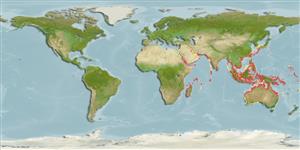Common names from other countries
>
Acanthuriformes (Surgeonfishes) >
Ephippidae (Spadefishes, batfishes and scats)
Etymology: Ephippus: Greek, ephippion, horse cloth, saddle.
More on author: Bloch.
Environment: milieu / climate zone / depth range / distribution range
Ecologia
marinhas associadas(os) a recifes; anfídromo (Ref. 51243); intervalo de profundidade 10 - 30 m (Ref. 9710). Tropical
Indo-West Pacific: Persian Gulf to Natal, South Africa, eastward to India and Lesser Sunda Island, Indonesia, north to Japan (Ref. 559) and Taiwan, south to northern Australia (Ref. 9710).
Tamanho / Peso / Idade
Maturity: Lm ? range ? - ? cm
Max length : 25.0 cm TL macho/indeterminado; (Ref. 559)
Espinhos dorsais (total) : 9; Raios dorsais (total) : 19 - 20; Espinhos anais: 3; Raios anais : 15 - 17. Head and body silvery blue-green. Four or 5 faint dark blue bars often visible on body. Fins dusky. Body orbicular and strongly compressed, its depth more than twice length of head. Eye above horizontal axis through mouth. Mouth small, the maxilla not reaching past vertical at front edge of eye. Jaws with bands of slender, incisiform teeth with a single lanceolate cusp. No teeth on palatines or vomer. Preopercle distinctly serrate, with a broad naked margin. Opercle without spines (Ref 43039).
Inhabits shallow water, over mud bottoms. Feeds on benthic invertebrates and fishes (Ref. 9616).
Ciclo de vida ou comportamento de acasalamento
Maturities | Reprodução | Spawnings | Egg(s) | Fecundities | Larvas
Kuronuma, K. and Y. Abe, 1986. Fishes of the Arabian Gulf. Kuwait Institute for Scientific Research, State of Kuwait, 356 p. (Ref. 5999)
Status na Lista Vermelha da UICN (Ref. 130435)
CITES (Ref. 128078)
Not Evaluated
Ameaça para os humanos
Harmless
Uso pelos humanos
Pescarias: espécies comerciais
Ferramentas
Relatórios especiais
Baixar XML
Fontes da internet
Estimates based on models
Preferred temperature (Ref.
115969): 24.7 - 29.2, mean 28.3 (based on 690 cells).
Índice de diversidade filogenética (Ref.
82804): PD
50 = 0.7500 [Uniqueness, from 0.5 = low to 2.0 = high].
Bayesian length-weight: a=0.02692 (0.01137 - 0.06373), b=2.94 (2.74 - 3.14), in cm Total Length, based on LWR estimates for this (Sub)family-body shape (Ref.
93245).
Nível Trófico (Ref.
69278): 4.0 ±0.61 se; based on food items.
Resiliência (Ref.
120179): médio(a), tempo mínimo de duplicação da população 1,4 - 4,4 anos (Preliminary K or Fecundity.).
Fishing Vulnerability (Ref.
59153): Low vulnerability (15 of 100).
